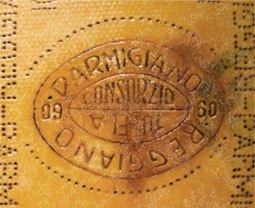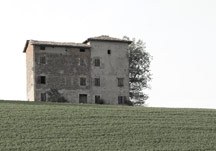History of Italian Hard Grating Cheeses
Meaning of Parmigiano and Reggiano
Since the ancient Romans, Italians have named their foods and wines for their places of origin. Parmigiano means simply “of or from Parma” and, likewise, Reggiano means “of or from Reggio.” Initially these were two similar hard Italian cheeses with an internal structure that was granular in appearance and texture, but made in two adjacent Italian provinces. Both were made from the milk of the same breeds of cows, both had their curds cut to the size of a kernel of wheat (grano is the Italian word for wheat) and both preserved the goodness of milk for long periods of time.
Origin of Parmigiano and Reggiano
The history of these cheeses can be traced back eight centuries when monks living in the Enza River Valley, which separated the provinces of Parma and Reggio Emilia, succeeded, with the help of irrigation systems, in pioneering the farming of dairy herds and the production of cheese on a marketable scale.This remarkable advance made it possible to better feed the population by preserving fresh milk in the form of large wheels of hard cheese, which could be aged for consumption over an extended period of time. Parmigiano cheese and Reggiano cheese, once aged until firm, could also be transported readily during this pre-refrigeration era.
Parmigiano and Reggiano Join Forces
Depending on where they lived, cheese makers in the area between Parma and Reggio called their cheese Parmigiano or Reggiano. Eventually, the two terms were combined to form the name familiar to us now: Parmigiano Reggiano® cheese.
 Though they were known by different names, these hard cheeses, Parmigiano and Reggiano, were heirs of the same soil, the same grasses, the same lines of cows, the same milk, and the same cheese-making traditions. In other words, they shared the same terroir, a word that alludes to the special characteristics a food derives from the geography, geology and climate of a place.
Though they were known by different names, these hard cheeses, Parmigiano and Reggiano, were heirs of the same soil, the same grasses, the same lines of cows, the same milk, and the same cheese-making traditions. In other words, they shared the same terroir, a word that alludes to the special characteristics a food derives from the geography, geology and climate of a place.
In 1934 cheese makers in Parma, Reggio and adjoining provinces with the same terroir joined forces to standardize the production of their cheeses. They made history in so doing, forming the oldest European organization, Consorzio del Grana Tipico, for the protection and promotion of cheese produced in a defined geographical region. (Note: The term “Grana” first came into use to indicate cheeses with a grainy structure, produced in the Po Valley from the eleventh century onwards.)
In 1954 the producers renamed their consortium to reflect the historic origins of their cheese: Consorzio del Formaggio Parmigiano-Reggiano. Today the full name of this cheese, Parmigiano Reggiano, is proudly displayed in pin dots on the rind of each wheel.
Parmigiano Reggiano Cheese, a World-Class Hard Grating Cheese
Parmigiano Reggiano is made with partially skimmed raw milk from cows fed only on the local grasses and hay of the place of origin. The milk is gently heated and, following the addition of rennet, coagulates to form curds, which are molded into large wheels and brined.
Other hard grating cheeses contain additives or are pressed, but these characteristics do not apply to Parmigiano Reggiano. Because the quality of the milk is high, Parmigiano Reggiano is suitable for lengthy aging, typically 18 to 36 months—longer than for most other types of hard grating cheese.
Other Hard Grating Cheese
 Grana Padano is produced in a large area of the Po Valley in 26 provinces to the north of the small five-province production zone reserved for Parmigiano Reggiano. Grana Padano is certified at 9 months and typically aged a total of 10 to 18 months.
Grana Padano is produced in a large area of the Po Valley in 26 provinces to the north of the small five-province production zone reserved for Parmigiano Reggiano. Grana Padano is certified at 9 months and typically aged a total of 10 to 18 months.
Other hard grating cheeses made in or near the Po Valley have been associated historically with the towns of Bagozzo, Lodi and Piacenza.
Uses of Parmigiano Reggiano
A statement attributed to the gastronome Massimo Alberini sums up the historical importance of Italy’s hard grating cheese: “It is, without doubt, the most typical Italian cheese, not only for its intrinsic value but, more important, for the contribution which it makes to the flavor and nutritive value of many dishes, from minestrone to pasta, from polenta to certain vegetables. [It] enriches without suffocating, gives vigor without overwhelming and, in particular, confers an Italian character to [each such dish].”